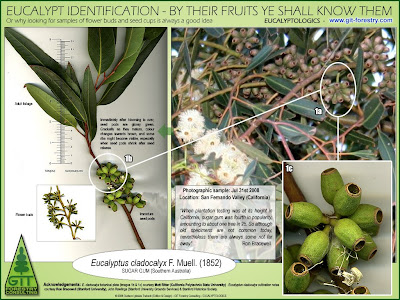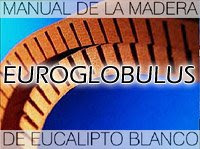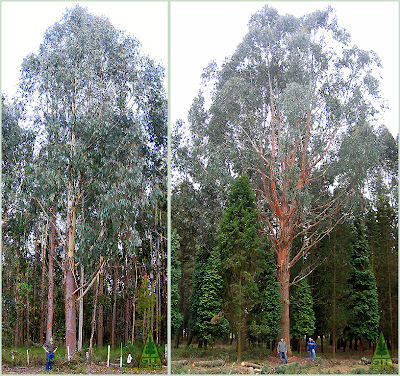By their fruits ye shall know them
Small tips on Eucalyptus Identification
Small tips on Eucalyptus Identification
Gustavo Iglesias Trabado 
GIT Forestry Consulting - Consultoría y Servicios de Ingeniería Agroforestal - www.git-forestry.com

GIT Forestry Consulting - Consultoría y Servicios de Ingeniería Agroforestal - www.git-forestry.com
Eucalyptus species determination is not just a matter of botanical interest. It can be quite important for its implications in regard to the different genetic pools (be them species, subspecies, provenances, or races) in cultivation. Important issues as cold hardiness (tolerance to winter frosts), growth rates (timber productivity) and physical and chemical properties of wood (timber quality) can depend on this variability, and hence be subject of forestry engineering.
Telling Eucalyptus species apart can be difficult or confusing if differentiation criteria are based on a limited amount of variables. Bark type and characteristics can be one of the criteria for species identification, and can be considerably useful sometimes because some species are so strikingly different nothing else is needed. The chances of using bark successfully as "main criterium" are better for areas where eucalypts are introduced species, simply because the number of possibilities tends to be more limited than in a multispecific natural forest in Australia.
However, bark based identification can also be misleading. Pictured above (Fig. 1) you have two different types of eucalypts. If based on "bark only" criteria, maybe the first thought is they are two different species. But in fact, we are seeing two types of eucalypt belonging to the same species, but different gene pools. Both are Alpine Ash, a type of Tasmanian Oak (Roble de Tasmania).
To the left (Fig. 1), the classical form, rough stringy bark in the lower portion of the main stem, clean withish bark in the upper portion and in the main branches. In mainland Southeastern Australia it has also received the vernacular name of "White Top". To the right, a variant, rough stringy persistant bark almost to the very top and on the main branches too. The latter type is restricted to natural habitats in Tasmania.
So, what the botanists say about this? Let's read Dean Nicolle:
- Eucalyptus delegatensis subsp. delegatensis (mainland Australia Alpine Ash) "Single stemmed tree 30 to 60 metres tall (...) Bark rough on the trunk up to 10 to 30 metres above ground level, moderately fissured and hard-fibrous, grey-brown; smooth above, ribbony, grey to pale grey over white"
- Eucalyptus delegatensis subsp. tasmaniensis (also known as E. tasmaniensis) "Single stemmed tree 20 to 90 metres tall (...) Bark rough over most of the entire trunk, moderately fissured and stringy-fibrous, grey brown to red-brown, smooth on branches, pale grey over cream"
An encouraging bark-based diagnosis indeed. But, back to the initial point, given the high chances of confusing both these types of eucalypt with others of the Ash type (E. obliqua, E. fastigata, E. regnans sometimes), and the extra options given by the possibility for some of these species to produce hybrid seed when grown in close spatial relationship, bark can help in some cases.
 Fig. 4: Example of botanical sample gathering methodology for accurate Eucalyptus species identification (Click to enlarge)
Fig. 4: Example of botanical sample gathering methodology for accurate Eucalyptus species identification (Click to enlarge)
But the most important information to work out what Eucalyptus we are seeing and defining geographically the original gene pools is to be sourced from comparison of flower buds and seed pods (fruit capsules) (Fig. 4) for the case of adult trees.
 Fig. 5: Example of mature Eucalyptus specimen bearing flower buds and seed pods (capsules), essential organs for accurate Eucalyptus species identification. (Click image to enlarge).
Fig. 5: Example of mature Eucalyptus specimen bearing flower buds and seed pods (capsules), essential organs for accurate Eucalyptus species identification. (Click image to enlarge).
Of course, once these trees are able to lure us into patient observation of their flower blooms and their seed bearing capsules in order to get them identified, little is left before you start collecting the later to obtain seed, and attempt to raise some plants.
Interesting links
Eucalyptus species identification (II): bark revisited




 Fig. 7: Different simultaneous stages of the reproductive cycle and eucalypt seed maturation process in a standing Snow Gum Eucalyptus tree.(Click to enlarge)
Fig. 7: Different simultaneous stages of the reproductive cycle and eucalypt seed maturation process in a standing Snow Gum Eucalyptus tree.(Click to enlarge)
 Fig. 8: Maturation stages for eucalypt fruits collected on Corymbia calophylla trees in a single visit, showing some of the internal organs within Eucalyptus infrutescences in each phase. (Click to enlarge)
Fig. 8: Maturation stages for eucalypt fruits collected on Corymbia calophylla trees in a single visit, showing some of the internal organs within Eucalyptus infrutescences in each phase. (Click to enlarge)
If you have an unknown eucalypt around and you are able to collect and photograph samples of the key organs needed for identification, do not hesitate contacting GIT Forestry Consulting.

If you are in the USA and find it easier to post fresh samples to a local expert, you can also contact Dr. Matt Ritter, resident eucalypt hunter at the California Polytechnic State University.
© 2007 Gustavo Iglesias Trabado. Please contact us if you want to use all or part of this text and photography elsewhere. We like to share, but we do not like rudeness.
 Fig. 4: Example of botanical sample gathering methodology for accurate Eucalyptus species identification (Click to enlarge)
Fig. 4: Example of botanical sample gathering methodology for accurate Eucalyptus species identification (Click to enlarge)But the most important information to work out what Eucalyptus we are seeing and defining geographically the original gene pools is to be sourced from comparison of flower buds and seed pods (fruit capsules) (Fig. 4) for the case of adult trees.
 Fig. 5: Example of mature Eucalyptus specimen bearing flower buds and seed pods (capsules), essential organs for accurate Eucalyptus species identification. (Click image to enlarge).
Fig. 5: Example of mature Eucalyptus specimen bearing flower buds and seed pods (capsules), essential organs for accurate Eucalyptus species identification. (Click image to enlarge).Of course, once these trees are able to lure us into patient observation of their flower blooms and their seed bearing capsules in order to get them identified, little is left before you start collecting the later to obtain seed, and attempt to raise some plants.
Interesting links
Eucalyptus species identification (II): bark revisited
Fig. 6a: Example of "bark only" diagnosis misleading Eucalyptus species identification

Fig. 6b: Example of "fruit & bud" diagnosis correctly leading to Eucalyptus species identification

Fig. 6c: Example of "fruit only" diagnosis correctly leading to Eucalyptus species identification

Fig. 6d: Example of "leaf helped" diagnosis correctly leading to Eucalyptus species identification

Fig. 6e: Example of "compared traits" diagnosis correctly leading to Hybrid Eucalyptus identification
 Fig. 7: Different simultaneous stages of the reproductive cycle and eucalypt seed maturation process in a standing Snow Gum Eucalyptus tree.(Click to enlarge)
Fig. 7: Different simultaneous stages of the reproductive cycle and eucalypt seed maturation process in a standing Snow Gum Eucalyptus tree.(Click to enlarge) Fig. 8: Maturation stages for eucalypt fruits collected on Corymbia calophylla trees in a single visit, showing some of the internal organs within Eucalyptus infrutescences in each phase. (Click to enlarge)
Fig. 8: Maturation stages for eucalypt fruits collected on Corymbia calophylla trees in a single visit, showing some of the internal organs within Eucalyptus infrutescences in each phase. (Click to enlarge)Find a local expert to ID your Eucalyptus
If you have an unknown eucalypt around and you are able to collect and photograph samples of the key organs needed for identification, do not hesitate contacting GIT Forestry Consulting.

If you are in the USA and find it easier to post fresh samples to a local expert, you can also contact Dr. Matt Ritter, resident eucalypt hunter at the California Polytechnic State University.
Subscribe to receive EUCALYPTOLOGICS via RSS
© 2007 Gustavo Iglesias Trabado. Please contact us if you want to use all or part of this text and photography elsewhere. We like to share, but we do not like rudeness.


































0 Comments by our readers :::
Send a comment to EUCALYPTOLOGICS